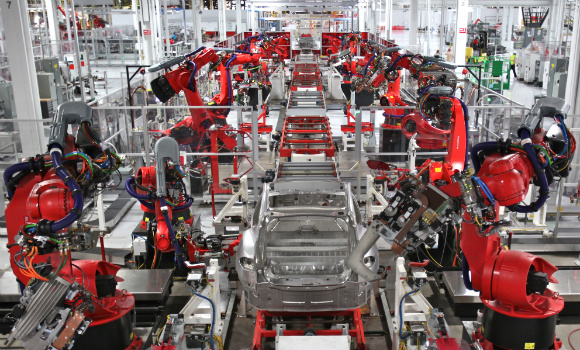
Tesla factory in Fremont, CA. (Photo Credit: Steve Jurvetson/Flickr)
When I was a young boy growing up in San Francisco, my mother once said, “I’ll give you an A for effort.” While she wasn’t praising for me results at that point, she acknowledged that at least I was trying.
She might also have said the same about Governor Brown’s office’s recent efforts on job creation, which apparently has been able to put the state back in the running for the coveted Tesla Motors battery plant. While some believe it is still a long shot, it’s much better than no chance, which is what we all believed was the situation a month ago. In fact, Tesla said as much.
The plant is expected to employ up to 6,500 people. The assumption is that the old GM plant in Fremont might be the location, but Forbes was reporting that Tesla has been buying up parcels of land in California, although they may not be tied to the battery plant.
Speaking with analysts this week, Tesla CEO Elon Musk said the company will break ground in June on the first of at least two “gigafactory” locations, and it may launch the second one shortly afterward. That California is back in the running is making national news.
The efforts are understandable in the wake of last week’s disappointing announcement that Toyota is moving 3,000 jobs from Southern California to Texas. As that story has unfolded, this development might be less about California’s business climate than it is about Toyota’s desire to move its sales and engineering jobs closer to its manufacturing in the south.
But losing 3,000 jobs is a blow to any economy and it started another discussion about California’s job creation potential. Los Angeles Chamber of Commerce’s respected President and CEO Gary Toebben opined in a blog that California must compete harder:
“What once was an easy decision to locate in our state or expand your business here, now becomes a cost/benefit analysis that includes dozens of domestic and international locations that would not have been considered in the past. And while our weather is still great, dollars increasingly top weather in the very competitive global marketplace that all companies operate within.”
And this week in an op-ed published by the Los Angeles News Group, the two co-chairs of the California Economic Summit Steering Committee wrote in the wake of the Toyota news how California can create more jobs and improve the state’s ability to compete in the global economy. Eloy Oakley and Paul Granillo pointed out seven areas that hundreds of Californians have identified through the Summit process as critical steps to achieving those goals.
- Workforce: Training workers for the new economy and advocating for increased funding of career technical education.
- Manufacturing: By advancing this industry, we are supporting a source of sustainable middle class jobs for years to come.
- Regulation: Reducing regulation uncertainty, thereby making California an easier economy to navigate.
- Access to Capital: Creating access to capital will ensure that entrepreneurial activity can happen everywhere in California.
- Infrastructure: Identifying ways to build and pay for the infrastructure needs of a growing population.
- Affordable Housing: Ensuring housing is available and affordable to our workforce.
- Working Landscapes: Leveraging present and future value of the state’s unparalleled landscapes.
The California Economic Summit embraces the diversity and dynamism of California’s economy. The regions in the Golden State have different economic drivers. Recognizing all those different elements is critical to developing sensible regional economic development strategies that benefit the overall California economy.

